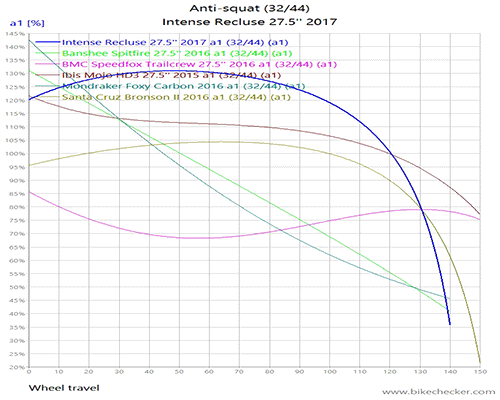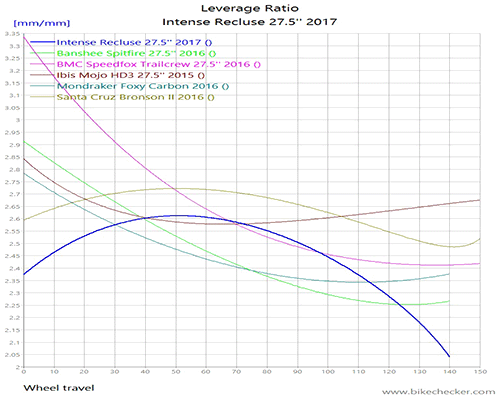En esta entrada voy a analizar a la Intense Recluse 2017, un nuevo modelo dentro del catálogo de Intense situado entre la Spider y la Tracer. Intense está renovando a todos sus modelos con una nueva versión del sistema VPP y el único modelo que falta por renovar es la Tracer, así que el analisis de la Recluse puede darnos algunas pistas sobre que va a pasar con la Tracer. En fin, dentro de unos meses saldremos de dudas, mientras tanto vamos a ver que tal funciona la Recluse, un modelo de Trail-AM con ruedas de 27.5'' y 140mm de recorrido trasero....
Como podéis ver en la tabla de excel y en las gráficas anteriores Intense apuesta por un sistema con unos porcentajes de Anti-squat altísimos (200%-125%) y esto va a provocar que el sistema tenga un funcionamiento muy firme en subidas. Unos porcentajes tan elevados dan la sensación de que el sistema tiene mucha Efectividad de Pedaleo, pero yo creo que esta sensación no se corresponde con la realidad, ya que el sistema no va a absorver bien el terreno en subidas técnicas. Como es lógico el Pedal-Kickback (24º) sube hasta unos niveles altísimos, mientras que el Brake-squat (89%) se mantiene en un nivel medio-alto, como suele ser habitual en la mayoría de Pivotes Virtuales...
En la gráfica del Leverage Ratio vemos como el sistema es Regresivo-Progresivo (2.4-2.6-2.05). El primer tramo tiene un tamaño importante (no es despreciable...) y el tramo medio es bastante lineal pero afortudamente los amortiguadores de nueva generación se adaptan muy bien a este tipo de LR. El tramo final es muy progresivo y creo que en ese aspecto no se le puede hacer ninguna crítica, sobre todo porque estamos ante un modelo de Trail-AM que en teoría no va a recibir un trato demasiado duro y que no va a ser utilizado en Bikeparks... En cuanto al amortiguador creo que hay que felicitar a Intense por utilizar uno de los mejores amortiguadores del mercado... El nuevo Fox Float X2, un detalle que solo encontramos en modelos de Enduro de gama alta y que hasta ahora nunca había visto en un modelo con 140mm de recorrido.
En la gráfica del Leverage Ratio vemos como el sistema es Regresivo-Progresivo (2.4-2.6-2.05). El primer tramo tiene un tamaño importante (no es despreciable...) y el tramo medio es bastante lineal pero afortudamente los amortiguadores de nueva generación se adaptan muy bien a este tipo de LR. El tramo final es muy progresivo y creo que en ese aspecto no se le puede hacer ninguna crítica, sobre todo porque estamos ante un modelo de Trail-AM que en teoría no va a recibir un trato demasiado duro y que no va a ser utilizado en Bikeparks... En cuanto al amortiguador creo que hay que felicitar a Intense por utilizar uno de los mejores amortiguadores del mercado... El nuevo Fox Float X2, un detalle que solo encontramos en modelos de Enduro de gama alta y que hasta ahora nunca había visto en un modelo con 140mm de recorrido.
Un saludo.










16 comentarios:
Saludos Antonio,
Estoy de acuerdo... si estos valores del anti squat son tan altos, el sistema dará la sensación de que es mucho más eficiente en las subidas pero la tracción en subidas técnicas se va ver afectada ya que el sistema se tornará más firme y perdería capacidad para "leer" el terreno. El pedal kikback también parece ser muy alto lo que también puede reducir un poco la sensibilidad del sistema en las bajadas.
Correct pedalling response and reduction in PK could be achieved by using a big chainring - a 42T. This would have the negative impact of causing the suspension to become somewhat too compliant during steep climbs and unless you had a bail out gear - the 32T would serve in that role quite well - you would lose the lowest climbing gear ratios making climbs very demanding. A 2-by 32/42T is likely the best solution, if you can get such a thing these days. There is a tab to accept a derailleur there and you should use it.
Un saludo
Chris
Es una bici de carreras y pide que la lleven como tal, ya te puedo decir que esta bici está muy lejos de otras 140 como la trance. Para que te hagas una idea es medio grado más abierta de dirección que la tracer.
Muy pedaleadora para salir fuerte de las curvas y es muy difícil que haga tope. El freno es para tocarlo fuerte y dejarla correr después.
Antonio, un opff topic: Estuve buscando en el sitio, y no vi que hayas hecho un análisis de las bieletas ultracompactas de Corsair (el llamado Konig Linkage). Ahora lo van a relanzar en la Ambush, una AM de 150mm. Podrías pegarle una mirada cuando tengas tiempo? Me intriga éste sistema, Pablo Tafoya dice que funciona un 90% como un monopivote pero al final del recorrido parece que las cosas cambian un poco.
Gracias desde ya!
interesante off topic
https://www.youtube.com/watch?v=CN22JaipAYM
pero tiene lo bueno del monopivote?¿ y lo malo no al tener bieletas?¿
Parece (por lo que ve en el vídeo), que en la parte final el KCBCK debe reducir la pendiente, para matener su valor dentro de valores aceptables.
Pura especulación, ojo.
Saludos.
Pablo Tafoya's linkage had a name - UNIT. That looks like an acronym but I have forgotten its meaning. Pablo was with Corsair Bikes for some time but they must have had a troubled relationship because Corsair dropped UNIT and Pablo departed Corsair in 2011. A long quiet period for Corsair ensued. Pablo went it alone for a while and then landed with Hyper Bikes. Apparently, Hyper are a well known BMX company and at the time they were making noises about a push into mountain bikes. The huge achievement of Hyper is to have failed to produce a single mountain bike for sale despite the talented people they have had on hand working to that end. They were quite good at producing prototypes that they didn't use though. Anyway, Tafoya and other well known mountain bike personalities at Hyper recognised the situation for what it was and left.
It is strange that neither Corsair nor Hyper saw the magnitude of Pablo's achievement with the UNIT linkage. It was the most compact dual short link suspension linkage ever produced and could easily be produced for short and long travel applications. With a bit of optimisation it could have been not just good but great. The DW6 linkage on the Robotbike R160 perhaps takes some inspiration from the UNIT linkage. Despite the obvious differences - the DW6 is a 6 bar and UNIT is a 4 bar - the compact linkage part of the DW6 looks like a refinement of design approach that Pablo had set in motion.
Today, Hyper remain kind of creepy and Eric Carter is at the helm of the purely cerebral mountain bike effort over there. I don't blame they guy, he should take the pay check while ever those weirdos keep handing it over. Corsair seems to have had new life breathed into it and are producing the UNIT based bikes again. However, I am not sure whether Pablo has any association with the company. It would be good to see a revised version of UNIT.
Pablo is a talented suspension designer. It would be good to see more from him.
Un saludo
Chris
Chris, as far as I know, Pablo works on a similar basis to DW. He gets hired by a bike brand to design a suspension layout which would fulfill said brand's expectations on a given application. That's how he devised the Hammer Link for Black Market (I had the privilege to ride a Killswitch a few years ago and I got pretty amazed of the capabilities it packed).
Thanks for bringing back the UNIT name, I forgot it completely. In a presentation video MTBR did with Pablo for the Konig launch he stated the system pivoted almost completely around the upper link's rear axis, and looking at a couple videos from Konig owners (suech as the one linked by Mi Isla de la Palma) you can see that's the case, but in maybe the last fourth of the travel the lower link's influence starts to weight more and more.
I agree with you on the Hyper topic. They should rename the brand to HYPE and call the day off.
Yo tengo en la base de datos a la Corsair The Captain del 2011 y el funcionamiento no está mal del todo, pero en el blog nunca llegué a escribir nada sobre ese sistema... Os lo subo a la biblioteca Online por si queréis darle un vistazo.
Un saludo.
Antonio, es que me interesaba la Ambush por salirse de la filosofía de Pablo de hacer un cuadro para 4615461854871 recorridos de suspensión ;-). Me parece que si se pone el target en un tipo de bici se puede optimizar un poco más el sistema.
SlimShady,
I wasn't aware that Pablo Tafoya was responsible for the Hammer Link but it doesn't surprise me to learn that he was. The Hammer Link shows that same economical form/compact implementation that is emblematic of his work. Thank you for mentioning it.
Cheers
Chris
Hola Antonio, una pregunta sobre esta bici. Voy a recibir este cuadro de Intense sin el amortiguador Fox X2. El amortiguador que tengo para ponerle a la recluse es un Cane Creek DBAir CS. Como funcionaria este amortiguador con este cuadro comparado con el Fox X2? Vale la pena reemplazar el Cane Creek DBAir CS que ya tengo con el Fox?
Gracias y saludos.
Hola Antonio. Yo acabo de comprar la recluse expert 2017 que viene con un shock rock shox monarch plus rc3. Que opinas de este shock junto con este cuadro?
Para empezar creo que vas sobrado, pero una vez que tengas toda la bici a tu gusto y no sepas muy bien por donde seguir mejorando XDDD el amortiguador va a ser un buen sitio por donde seguir avanzando, sobre todo si la llevas con una horquilla de 160mm.
Un saludo.
Hello Antonio.
At first, thanks for your great website and expertise!
I built a Recluse few months ago and here are my observations.
I've built with Öhlins air shock with standard air chamber size and single 36T chainring, which is actually the largest useable single-ring since teeth are almost touching the chainstay.
When the sag set properly (apprx 25%) and dampers somewhat "normal", bike uses the travel quite well and feels good. Small bump sensitivity is not any close to DH bikes and I wouldn't mind going little more plush, but that is probably how the AM trail bike is meant to be.
What worries me most (1) is the pedal bob. My previous frame was a horst link with air shock and it almost didn't move under moderately strong pedalling. When riding Recluse, I can observe approx 5mm (9% travel) movement in the shock stroke under such conditions. How does this correlate with your results and graphs? I thought high anti-squat and PK numbers would prevent this.
Worry nr. 2 - after every ride, my shock shaft ring is pushed approx 5mm from the bottom (90% of the travel) even when no big hit occured. Adding more pressure into the shock negatively affects sensitivity but doesn't help with this.
Problem nr. 3 - bike stiffens quite significantly under braking. Am I in the wrong segment of rear wheel travel according to rear wheel path?
My shock was provided with possibility to change air chamber size. I can also change high and low speed damping.
Would you reccomend to change air chamber size? Going smaller would probably help with sensitivity, but I am afraid to make problems 1 and 2 even worse. Or would enlarging the chamber (so going less progressive) help?
Thanks for your advice!
Peter
Dude your shock is likely broken....
Publicar un comentario